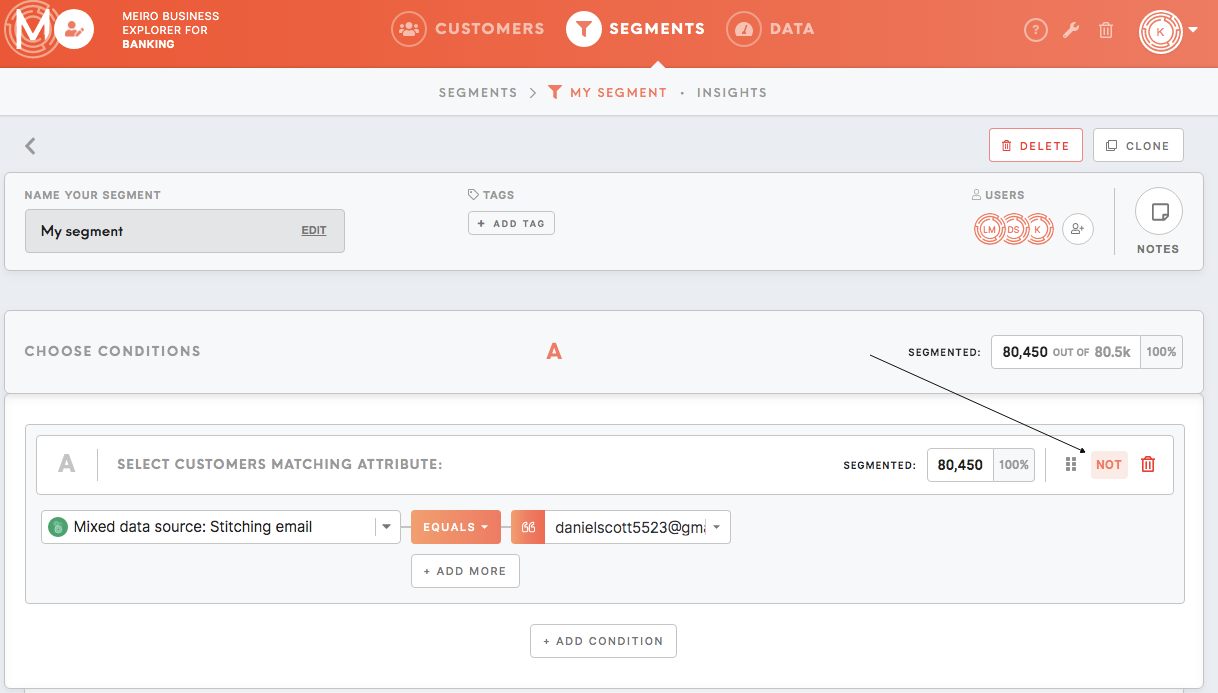Segment builder: attributes & conditions, compound attributes, parentheses, exclusion
|
Learn from this article about:
How to add attributes, conditions, move and delete them Attributes and compound attributes, data types and conditions |
How to add attributes, conditions, move and delete them
Conditions
It needis possible to beset definedconditions for each attribute in the segment. They are used to specify attributes and narrow the audience.
Go to the Segment Detail tab (either create a segment or edit an existing one) and click on the button "Add Condition". You can add as many attributes as you wish and specify a condition or various conditions for each of them. each.
Attributes and compound attributes, data typestypes, and available conditions
Various attributes are definedin as a specificcertain data type,types. inIn most casescases, those are:
- string (attributes like "city" with
variousdifferent cities assigned to each customer) - numeric (attributes like "number of transactions" with
variousother numbers for each customer) - date (or datetime) (attributes like "date of birth" with various dates for each customer)
- boolean (attributes like "subscribed to the newsletter" with option yes/ no)
Each of the attributes has certain conditions available based on the above-types mentioned types.above.
| Attribute data type | Conditions |
| String attribute |
Equals Not equals Contains Not contains Is known Is unknown Remember: String conditions are not listed in alphabetical Remember: Search is case-insensitive. |
| Numeric attribute |
Equals Lower than (for lower than is equal and lower than defined number) Greater than (for greater than is equal and greater than defined number) Between ( from equal and higher to equal and lower than defined number) Is known Is unknown Remember: Attributes greater than 0 does not include 0. |
| Date (datetime) attribute |
Exactly Since Until Since- until Matches current day Matches current week (coming soon) Matches current month Matches current year Learn more: To learn more about the date (datetime) attribute and how to use them, please refer to this article. |
|
Yes No |
Compound attributes
Some conditions have more dimensions that are built from compound attributes (like in the example below for the "Current subscription status" attribute, we have various dimensions available "Email", "subscription status", Date of subscription status").
Compound attributes work exactly the same as other attributes,attributes. theyThey are there to help you to see that they belong to the same group of attributes logically put together.
"And"/ "or" operators
In between, you can choose the operator "and/ or" to specify the segmentation query further.
Remember: AND has higher precedence over OR. For example, if defined A and B or C, in fact if will behave in this way: (A and B) or C.
Exclusion
It is possible to set condition negation by clicking on the "Not" button. In this way, it is possible to exclude certainspecific values.
For example, choose all customers who do not equal email denielscott5523@gmail.com, as we wish to exclude this particular customer.
Parentheses
Set parentheses () to specify query. For example, "(A or B) and (C or D)": customers from "(A Jakarta or B Singapore) and (C subscribed to an email or D made a transaction)".
Remember: AND has higher precedence over OR. For example, if defined A and B or C, in fact if will behave in this way: (A and B) or C.
|
Example 1: Segment customers |
|
|
Example 2: Segment customers that have made a transaction in the current year and spent |
|
Tutorials
Customers who have email engagement in a particular country
Customers who visited the website, added items in the cart but left without a purchase
Engaged customers who prefer browsing on a mobile device
Website visitors who are non-customers





